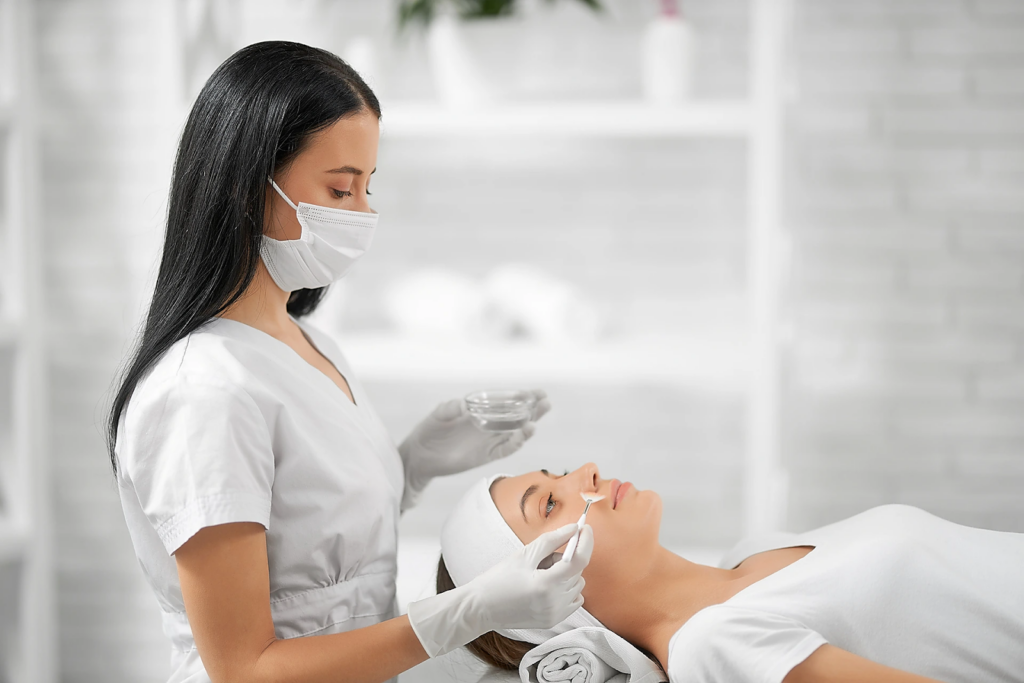
In many cases, the beauty industry and those working in it can be confusing. The goal of this article is to explain what an aesthetician does, what they do not do compared to estheticians, their training programs or paths that one can take to become a licensed professional as well as some common questions people have about these two professions.
What is the main difference between an aesthetician and an esthetician?
Aesthetician and esthetician are terms often used interchangeably, but aestheticians typically focus on medical skincare treatments, while estheticians provide cosmetic skincare services. Aestheticians work in medical settings like dermatology clinics, whereas estheticians are often found in spas and salons, offering facials, waxing, and skincare consultations.
One of the key differences lies in scope and work settings. Much of the time, aestheticians work alongside medical professionals, receiving training for advanced treatments and even performing part of the medical procedures. They can work on post-surgical skincare or even medical-grade peels.
Estheticians, however, look into beauty treatments and the relaxation of clients. They are competent in enhancing aesthetic appearance using facials, massages, and the proper beauty products to recommend for better skin. This division reflects the difference in educational streams and certifications required for each profession.
What qualifications are required to become an aesthetician?
The qualifications to become an aesthetician are, one must obtain a certificate or diploma in the field and pass state licensing exams. For specialized procedures such as laser therapy or chemical peels, advanced training in medical aesthetics is often necessary.
Additionally, continuous education is crucial to stay current with the latest skincare technologies. It is essential to keep up with the advancement in the industry through attending workshops and seminars, for this will enable aestheticians to administer the latest and most effective treatments.
Where do estheticians typically work?
Estheticians primarily work in salons, spas, and wellness centers. Their tasks normally revolve around the administration of facials, waxing, and other beautification treatments such as makeup. A few are also found in retail stores to advise clients on the use of certain products to maintain skin health or their beauty regime.
They can find employment not only in salons and spas but also in luxury resorts, cruise ships, and in boutique studios that specialize in skincare. Some estheticians decide to pursue certain niches within the profession, such as eyebrow shaping or bridal makeup, in order to customize their services to suit specific needs.
Some get employment in retail, while others use the experience in training clients on various skincare products, hence maximizing sales and leading these clients in attaining their goals in skincare.

What services do medical aestheticians offer?
Medical aestheticians offer advanced skincare services, including chemical peels, microdermabrasion, laser treatments, and acne treatment. They work in medical settings like dermatology clinics and plastic surgery offices, assisting with pre- and post-operative care and collaborating with healthcare professionals to provide comprehensive skincare solutions.
Literally, medical aestheticians bridge the gap between aesthetic beauty and medical skincare. They conduct advanced exfoliation, LED therapy, microneedling, and other procedures aimed at enhancing skin health or resolving certain issues such as scarring and pigmentation. A great portion of their work consists of educating patients about their treatment plans and what they can expect from the results.
Medical aestheticians work hand in hand with dermatologists and surgeons in ensuring safe and effective treatments that set patients on the best route to recovery and maximize the results achieved. They can also help design skincare routines for clients with conditions such as eczema or psoriasis, thus offering holistic care.
How do estheticians stay current with skincare trends?
Estheticians stay current by attending workshops, seminars, and industry conferences. They also participate in continuous education programs, subscribe to professional journals, and network with peers to exchange knowledge. Staying informed about the latest skincare products and techniques is crucial for providing cutting-edge services to clients.
Continual education is the key to giving the best to clients and to be competitive. Workshops and trade shows introduce estheticians to new tools and products firsthand. Professional journals and online courses help them be better equipped with knowledge regarding emerging techniques and technologies.
The networking events benefit in exchanging innovative ideas among the different professionals in this industry. It is continuous education that will upgrade esthetician skills, and enhance their credibility, and flexibility toward the clients’ needs, thus keeping them competitive in their fast-moving industry.
What career opportunities are available for aestheticians?
Aestheticians can work in dermatology clinics, medical spas, and plastic surgery centers, providing specialized skincare treatments. Opportunities also exist in sales, education, and product development within the skincare industry. Advanced certifications can lead to roles in laser technology or clinical research, broadening career prospects significantly.
Regarding business, aestheticians might transfer into sales or marketing for skincare brands, representing products well by applying knowledge of how the products work on skin. On the teaching side, opportunities await in beauty schools teaching and training the next generation of skincare professionals.
Furthermore, product development or skincare technology research roles open up opportunities for those who are more interested in the scientific part of the industry.
How do aestheticians and estheticians collaborate with healthcare professionals?
Aestheticians collaborate with dermatologists and plastic surgeons, assisting with patient care and providing skincare treatments that complement medical procedures. Estheticians may work alongside nutritionists and wellness coaches to offer holistic skincare advice, ensuring comprehensive care that addresses both cosmetic and health-related skin concerns.
Collaboration between aestheticians, estheticians, and healthcare professionals drives better patient outcomes and is integral to holistic care. It is common to find aestheticians supporting treatments like pre-operative skin preparation and post-surgical aftercare, which lets medical treatments have the best possible outcomes.
Many estheticians support wellness programs by providing skincare consultations consistent with those on nutrition and lifestyle. Both professionals work together to provide the inner and exterior aesthetics and health of a client’s skin for a holistic approach to the well-being of the client. It is through such partnerships that high levels of client satisfaction can be achieved and the real value of integrated care in meeting beauty and health goals established.
Conclusion
In summary knowing the distinction between an aesthetician and esthetician can greatly assist someone in choosing their right path career wise since both professions have similar goals which is taking care of people’s skins but through different ways that may involve while aesthetics concentrates on medical aspects like treating diseases or conditions affecting skin health – cosmetic skincare is all about making people look good, which explains its popularity among women, especially younger ones who want quick results without much hassle involved.
